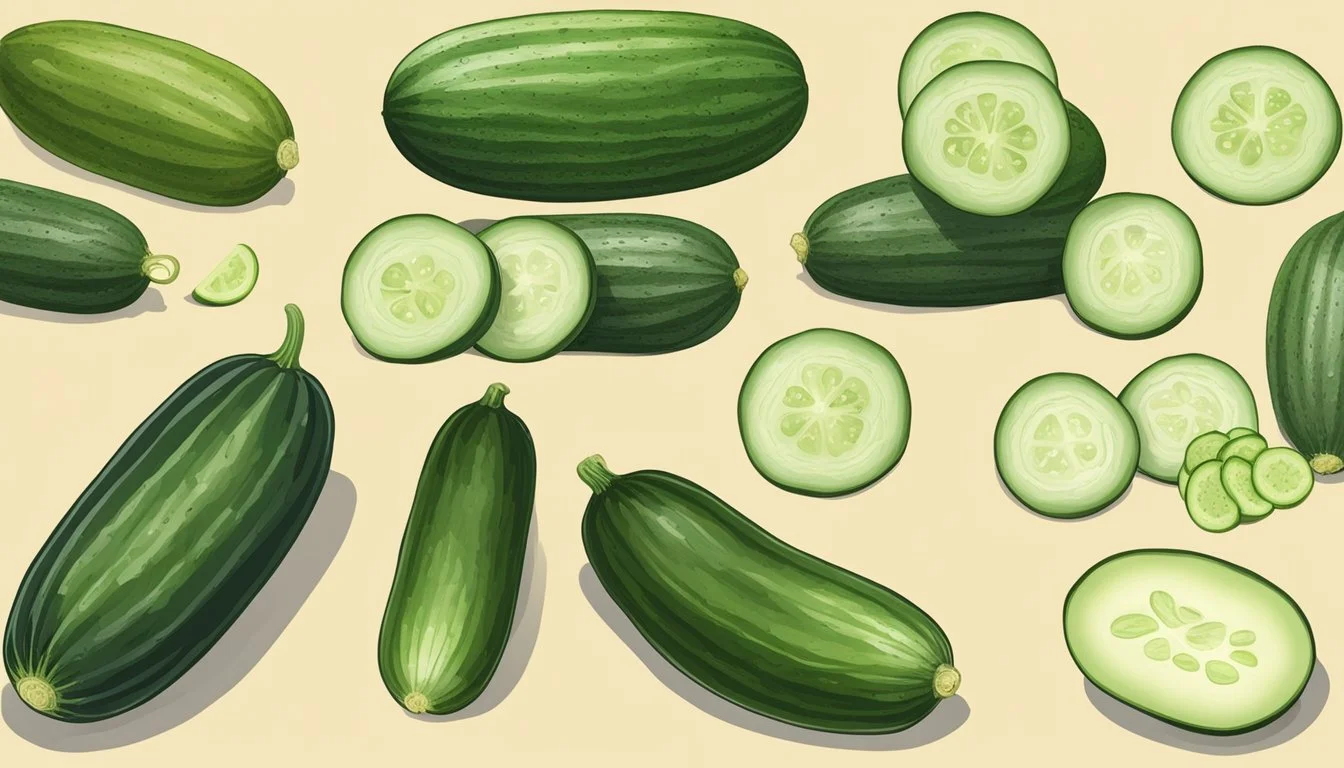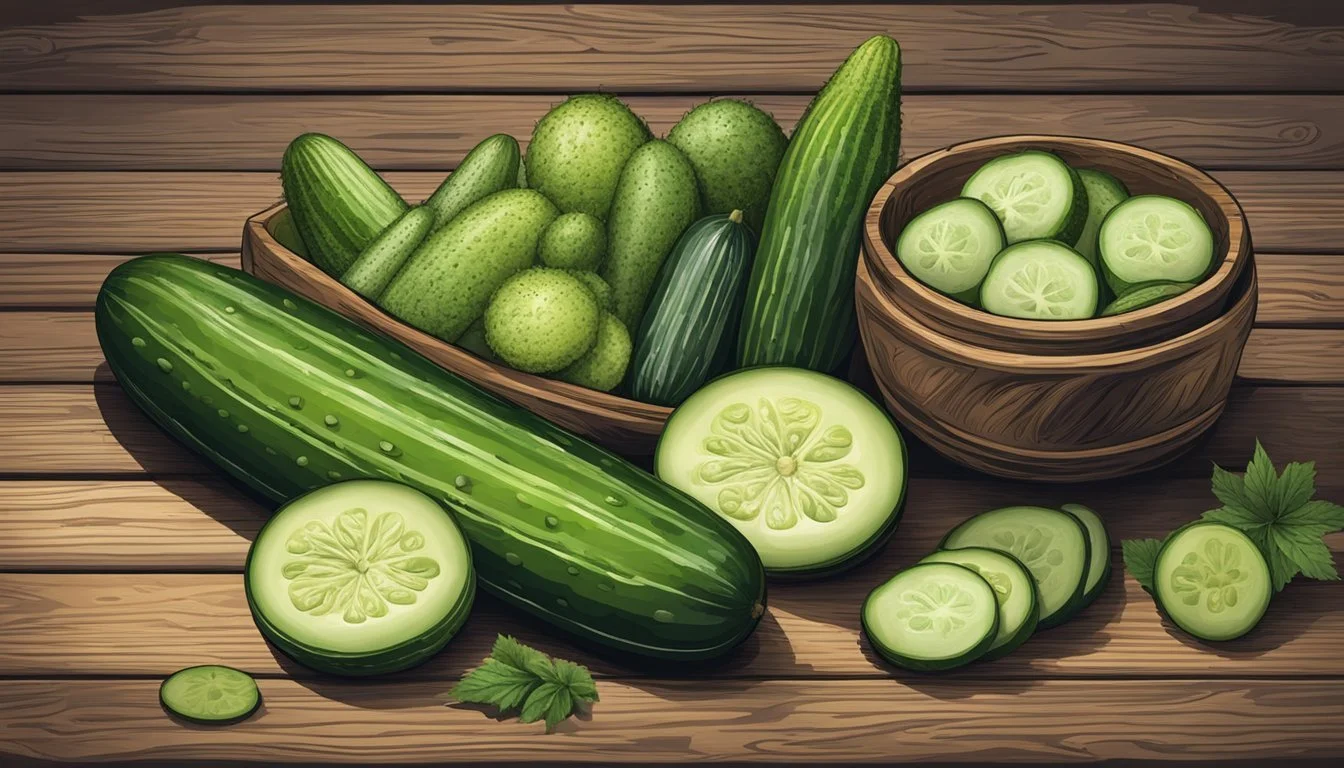Armenian Cucumber Substitutes
Top Alternatives for Recipes
Finding the perfect substitute for Armenian cucumbers is essential for many culinary enthusiasts. Armenian cucumbers are actually a variety of melons that look almost identical to regular cucumbers and can seamlessly replace them in numerous dishes. Known for their slightly sweet and crunchy texture, they enhance both raw and cooked recipes effortlessly.
When considering alternatives, Persian cucumbers stand out as an excellent pick. They share a similar cylindrical shape and crunch, making them a versatile option for salads and snacks. Japanese and Kirby cucumbers also serve as fantastic substitutes, each bringing their unique textures and flavors to the dish. Japanese cucumbers, being slim and seedless, offer a crisp and refreshing bite, whereas Kirby cucumbers are small and firm, perfect for pickling or adding a crunch to cooked recipes.
Other vegetables can also replace Armenian cucumbers in certain dishes. Radishes add a peppery kick to salads, making them a vibrant alternative. Green apples, with their fresh and tart flavor, can be used in dishes seeking a lighter taste. These varied options ensure that anyone can find a suitable substitute that maintains the integrity and appeal of their favorite recipes.
Understanding Armenian Cucumbers
Armenian cucumbers, also known as snake cucumbers or yard-long cucumbers, are distinguished by their elongated shape, mild flavor, and crisp texture. They are prized in culinary contexts for their versatility and nutritional benefits, such as being rich in vitamins and minerals.
Characteristics and Culinary Uses
Armenian cucumbers are easily recognized by their long, slender, and slightly curved appearance.
They resemble traditional cucumbers but are botanically classified as melons. Their skin is thin and smooth, which means they do not require peeling. This characteristic makes them user-friendly in both preparation and presentation.
They are popular in a variety of dishes. They can be used raw in salads, offering a crisp texture and a mild, refreshing flavor. Armenian cucumbers can also be grilled, sautéd, or pickled, making them a versatile ingredient in both hot and cold dishes.
Nutritional Profile
Armenian cucumbers are not only versatile but also nutritionally rich.
They are high in Vitamin C, which is essential for immune function and skin health. They also contain significant amounts of potassium, which helps regulate blood pressure and supports heart health.
The thin skin contributes dietary fibers, aiding in digestion. Compared to other cucumbers, Armenian cucumbers are low in calories but provide a good source of hydration due to their high water content.
These vegetables are easy to digest and are often referred to as "burpless," meaning they do not cause the same gastrointestinal discomfort as other varieties might.
In summary, Armenian cucumbers offer both culinary flexibility and a robust nutritional profile, making them an excellent addition to various diets.
Choosing Substitutes for Armenian Cucumbers
Selecting the right substitutes for Armenian cucumbers involves understanding both the flavor and texture of alternatives as well as their culinary applications. Consideration of similar cucumber varieties and specific factors will aid in making the best choice.
Similar Varieties and Alternatives
English Cucumbers: They have a mild flavor and a thin skin, making them a suitable substitute for raw salads. Their similar crunch and watery texture enhance dishes well.
Japanese Cucumbers: With their crisp texture and minimal seeds, Japanese cucumbers are a great alternative. They provide a slightly sweeter taste, ideal for fresh dishes.
Kirby Cucumbers: Though typically used for pickling due to their firm and crunchy nature, they can also be a substitute in cooked dishes. Their bitterness might not be suitable for raw uses.
Factors to Consider When Selecting Substitutes
Flavor Profile: The mild and slightly sweet flavor of Armenian cucumbers means substitutes should not be overpowering. Japanese cucumbers are a good match, while Kirby cucumbers might require additional preparation to reduce bitterness.
Texture: Crunch and water content are key. English cucumbers and Japanese cucumbers have the desired crunchy texture.
Culinary Application: For salads, raw substitutes like English or Japanese cucumbers are ideal. For cooking or pickling, Kirby cucumbers can be more appropriate.
Availability: Ensure substitutes are locally available. English cucumbers and Kirby cucumbers are often easy to find in grocery stores. Experimenting with different substitutes allows for discovering new flavors and textures while maintaining the desired qualities of the original ingredient.
Alternative Ingredients for Specific Dishes
When substituting Armenian cucumbers in recipes, other ingredients can be used to mimic their crisp texture and refreshing taste. Different substitutes are more suitable for specific applications, whether in salads or cooked dishes.
Salads and Raw Applications
In salads and other raw dishes, choosing a substitute that matches the crisp and refreshing nature of Armenian cucumbers is essential.
Celery is an excellent choice due to its crunchy texture and light flavor. It adds a similar crispness to salads and can be chopped or sliced thinly.
Jicama offers a refreshing bite, comparable to the texture of Armenian cucumbers. It's slightly sweet and very crunchy, making it a versatile ingredient in various raw recipes.
Bell Peppers bring a different flavor profile but add a nice crunch and a pop of color. They work well in salads, providing both visual appeal and texture.
Using English Cucumbers can also be effective. They are seedless and have a mild taste, which makes them suitable for salads. They can be sliced thinly or chopped, depending on the dish.
Cooked and Pickled Preparations
For cooked or pickled dishes, texture and ability to hold up under heat or in brine are crucial.
Kirby Cucumbers are firm and can be pickled or cooked. Their small seeds and thin skin make them ideal for these applications, providing a good bite without becoming mushy.
Japanese Cucumbers are another suitable option. Their thin skins and fewer seeds make them good for cooking and pickling. They retain a nice crunch even after being exposed to heat or vinegar.
Zucchini can serve as a substitute in cooked dishes. Though it has a different flavor, it has the firmness needed for grilling, roasting, or sautéing. When pickled, it absorbs flavors well and maintains texture.
Lemon Cucumbers can also be used for their crisp texture in both cooked and pickled recipes. Their unique appearance and mild flavor make them a refreshing substitute, particularly in pickling.
These substitutes can seamlessly integrate into various preparations, maintaining the desired texture and refreshing qualities in your recipes.
Other Vegetables as Substitutes
When looking for substitutes for Armenian cucumbers, various vegetables can provide similar textures and flavors. Here are the important options broken down into different categories.
Root Vegetables and Tubers
Radishes: Radishes offer a crisp texture with a unique peppery flavor, making them a great alternative in salads and slaws. Their distinctive taste can enhance dishes where Armenian cucumbers might be used for crunch.
Jicama: Jicama provides a crunchy, slightly sweet alternative. It’s ideal for raw dishes, where its texture mimics that of cucumbers. Thinly sliced jicama can be added to salads or used as a crunchy topping for tacos.
Leafy Greens and Herbs
Celery: Celery's crispness is a good match, especially in salads and cold dishes. Its mild flavor ensures it complements other ingredients without overpowering them. Diced celery can substitute for cucumbers in many recipes.
Green Bell Peppers: Offering a slightly sweet and crisp profile, green bell peppers are versatile and work well in many cold dishes. Their firm texture makes them suitable for chopping into salads or using as a fresh topping.
Squashes and Melons
Zucchini: Closely resembling cucumbers in both texture and mild flavor, zucchini can be used raw in salads or as a cooked ingredient in various dishes. Sliced zucchini provides a similar crunch and appearance.
Summer Squash: This versatile vegetable can stand in for cucumbers in both salads and cooked applications. Its tender flesh and mild taste make it a flexible substitute.
Green Papaya: Green papaya, when shredded, makes for a crunchy and mildly flavored alternative. It is often used in salads, where its texture and slight sweetness can shine similarly to cucumbers.
Other Melons: Vegetables like bitter melon or less common options such as cucuzzi might also be considered. While their flavors vary, their similar shapes and firm textures can provide useful alternatives in various dishes.
Incorporating these substitutes can enhance the variety and flavors in your cooking, offering refreshing and nutritious alternatives when Armenian cucumbers are unavailable.
Texture and Flavor Profiles
Armenian cucumbers offer distinct textural and flavor qualities. Readers will learn about crunchiness and mouthfeel, as well as taste comparisons with various substitutes.
Crunchiness and Mouthfeel
Armenian cucumbers are recognized for their crisp texture and refreshing crunch. Their overall mouthfeel is light and satisfying.
Persian cucumbers provide similar crispness, yet tend to be slightly firmer. Substitutes like celery and jicama also mimic the crunch, though celery may be stringier. Borage leaves offer a comparable bit of crisp, but the leaves can be slightly more fibrous.
Green papaya provides a surprising match in texture with its firm and crunchy bite. Chinese Yellow Mirror Cucumbers are another option; they maintain a light crunch similar to Armenian cucumbers but might feel slightly sturdier.
Taste Comparisons
The taste of Armenian cucumbers stands out for its mildness, with a hint of sweetness and a peppery flavor. This balance contributes to their versatility in dishes.
Persian cucumbers have a comparable mild yet sweet flavor profile. Celery, while crunchy, introduces a more prominent peppery undertone, which can alter the dish’s overall taste. Jicama offers a mildly sweet flavor that aligns well with Armenian cucumbers but does not carry the peppery note.
Borage leaves provide a unique minty and cucumber flavor, making them an interesting but distinct substitute. Chinese Yellow Mirror Cucumbers share a similar mildness but offer a slightly richer aroma and zest. Green papaya retains a neutral taste akin to cucumbers, but lacks their unique peppery edge.
Usage Tips for Cucumber Substitutes
When using cucumber substitutes, consider their water content, texture, and whether they have thin skin or are seedless. Preparing and storing these alternatives properly ensures optimal freshness. Additionally, their appearance and flavor can enhance various dishes.
Preparation and Storage
Armenian cucumbers and similar substitutes often have thin skins, which may not need peeling. If using substitutes like zucchini or jicama, peel as needed due to their thicker skins. Cutting these vegetables into similar shapes and sizes as cucumbers ensures even cooking and consistency.
To maintain freshness, refrigerate cucumber substitutes in airtight containers or wrapped in damp paper towels. This helps retain their crisp texture and moisture. For water-rich substitutes like celery and green bell peppers, keeping them hydrated by storing in a bit of water can prevent drying out.
Serving Suggestions
Cucumber substitutes are versatile in many dishes. Armenian cucumbers, with their crisp texture and mild flavor, work well in salads and as garnishes. Alternatives like radishes or fennel add a unique taste and crunch to appetizer platters. Seedless options provide a smoother bite and are great for sandwiches.
For cold dishes, these substitutes can contribute to refreshing flavors without becoming soggy. Incorporating green beans or squash into stir-fries or roasted vegetable dishes adds variety and maintains their appearance and texture. Use thinly sliced green papaya or borage leaves to add interesting texture and flavor to seafood dishes or soups.






